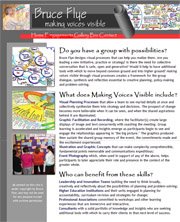In the year and a half that I’ve been working with groups using 4 feet wide rolls of paper, markers and chalk I have yet to leave a meeting without hearing positive comments about the graphics. I consider myself more of a draftsman than an artist, but I was lucky to have picked up markers from The Grove and some very ordinary chalk that give good results without a lot of fuss. But still I wonder: is it really meat or just sizzle?
The first architect I ever worked for could really draw. With a Scripto mechanical pencil containing a piece of 2B lead, he could create a perspective sketch that you could walk into, and do it as though he were tracing. He once said “People are fascinated by the ability to draw. Once you start drawing in a meeting, you can absolutely control the situation.” OK – is that good, or could it be not so good?
In the Spring of ’06 a couple of us worked with an academic department on their strategic plan, and we used wall graphics exclusively. Six months later I visited the Chair to inquire about what the lasting impact had been, and in the course of the conversation I queried him on the use of the graphics. His response was “It’s very powerful, but you’ll have to be judicious with it.”
That very evening, UNC-TV broadcast an interview with the artist Herb Jackson. (See this post also.) He talked about how we grow up with images in storybooks and such, and they are always shown to us as a “picture of” something. As we make our first drawings, we are always asked what they are pictures of.
It would seem that as graphic facilitators we have to embrace that constraint, as our value is in representing what the group is feeling and saying in a way that makes it real through visibility. We carry images of our past, and we hold onto images of what we think the present is; both are constructed from things we have seen in the world. There is no “directly observable data” about our future. By providing the images, we can begin to make that third element of time competitive with those other two.
It would seem that relationships can be helped in the same way, whether they are among facts, ideas or people. A form of reality is created with which we can interact.
The following observation appeared in an AIA newsletter, attributed to Robert M. Beckley, FAIA, professor and Dean Emeritus at the
Arguably, architects can be somewhat encumbered by the eventual need to produce construction. Graphic facilitators have both the privilege and the challenge of a much broader expanse of possibilities.


No comments:
Post a Comment